Raising Heritage Turkeys for Thanksgiving
There’s something special about gathering with friends and family for a traditional Thanksgiving feast, complete with roast turkey and all of the trimmings. I think that our society has, perhaps, lost a little bit of the spirit of Thanksgiving. With prosperity and an abundance of food in our country, many have come to take Thanksgiving for granted.
The supermarkets sell mass-produced turkeys for a pittance to attract consumers to their stores. Plump birds injected with saline solution and fitted with pop-up timers are sold by the millions in November and December, in preparation for the holidays. Most of these birds are Broadbreasted White turkeys, bred for such copious amounts of breast meat that the males are no longer physically capable of breeding naturally. The turkey industry uses artificial insemination to produce these birds and we gobble them up with little regard for their unhappy living conditions.
My family likes to have a nice turkey for Thanksgiving too. However, we would much prefer to dine on a bird that had a good life and humane death. To ensure that my family is eating a bird that I feel good about serving, I began raising my own heritage turkeys this spring. If you would like to read more about raising your own turkeys, please visit my post How to Raise Turkeys.
I began with a trio of Narragansett turkeys, one male and two females. I’ve shared some of the ups and downs of my heritage turkey experience in my posts Bringing Home Heritage Turkeys and Heritage Turkey Eggs.
Butchering a Heritage Turkey
If you would like detailed instructions, please visit my post How to Butcher a Turkey.
I had originally planned to butcher all of the tom turkeys just before Thanksgiving so we could have a fresh turkey for our table. However, the male turkeys are becoming very aggressive, especially at feeding times. So my plans changed and I butchered the largest one yesterday and sent him to freezer camp. The other males will follow soon but all three hens will be kept for breeding next year. A new tom will come to live with our flock after the turkey butchering is done for the fall. This will introduce new genetics, making next year’s poults stronger.
After decapitating the turkey, I scalded it to make plucking easier. The Narragansetts have dark feathers which make it more difficult to get a clean-looking carcass for the table. I spent a lot of time removing the little black feathers. The dressed weight of my bird was approximately 13 pounds. There was quite a bit of fat around the neck and breast of this bird, which I attribute to the black oil sunflower seeds I’ve been feeding them for extra protein. I think I’ll feed the rest of the birds more split peas and fewer sunflower seeds to decrease the fat content.
What’s the Difference Between Heritage and Supermarket Turkeys?
The two biggest differences between the heritage turkeys and the broad-breasted breeds sold at the grocery store are the flavor and the amount of breast meat. A heritage turkey will look somewhat skinny compared to your supermarket bird. Since they have not been bred for huge amounts of fast-growing breast meat, the heritage birds are smaller and have more dark meat than white meat. But the flavor! Oh my! I have never tasted such a delicious turkey before…including the broad-breasted turkeys I raised in the past.
Read more about the pros and cons of raising heritage vs broad-breasted turkeys.
Should You Raise Your Own Turkeys?
Raising and butchering your own turkeys is definitely not for everyone. They need more space than chickens and, ideally, they should be raised in a separate pen from chickens. (I have mine together and haven’t had any disease problems, but this may not be your experience.)
Turkeys are friendly, curious birds and I think they are smarter than chickens. They also need a higher protein feed than chickens do, making their feed more expensive.
I have found that it is possible to raise them with the layer feed given to the chickens along with sunflower seed, scratch grains, and split peas. The sunflower seeds and corn should be kept to a minimum in warm weather.
No one but you can determine if raising your own heritage Thanksgiving turkey is right for your homestead. But if you do decide to take the plunge and purchase turkeys, I can say that you’ll get hours of entertainment watching their antics!
Read more about Heritage Turkey Breeds for Your Homestead!

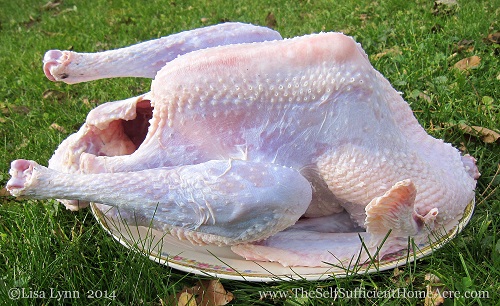
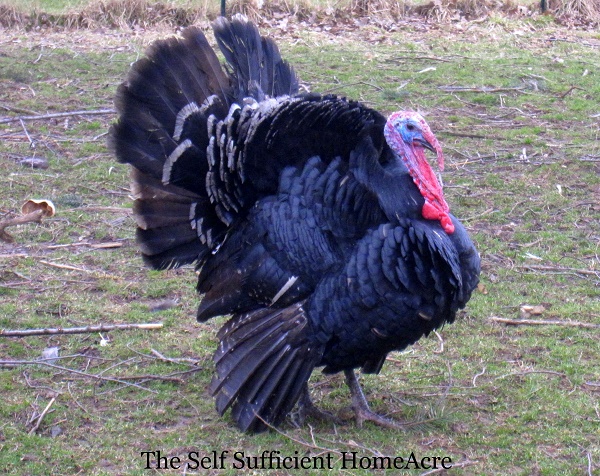

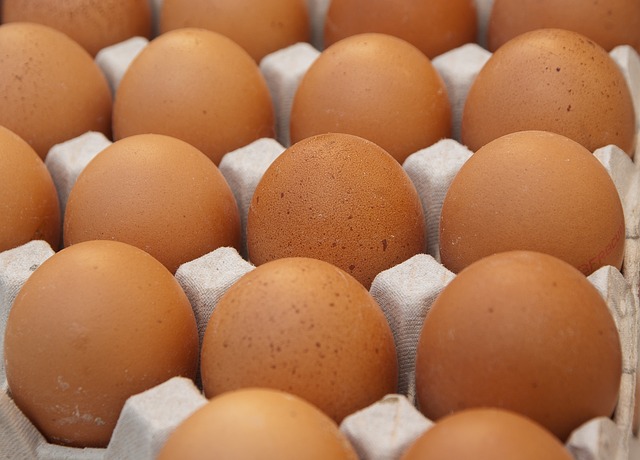
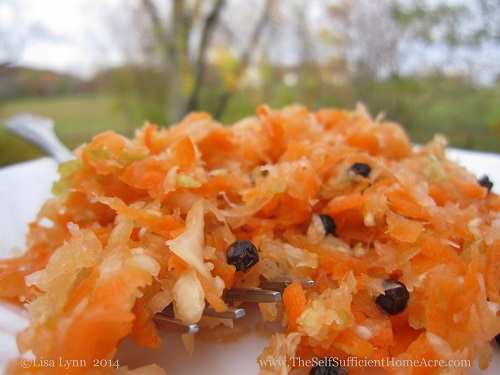
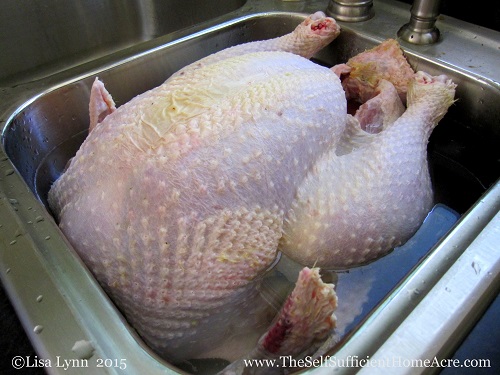
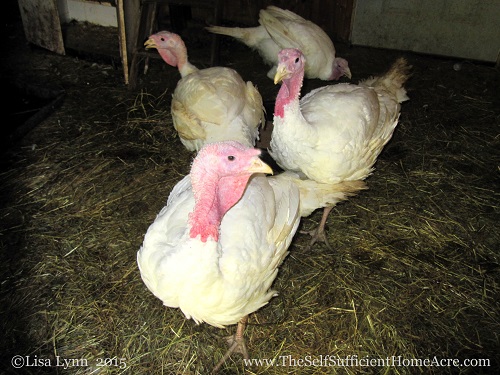
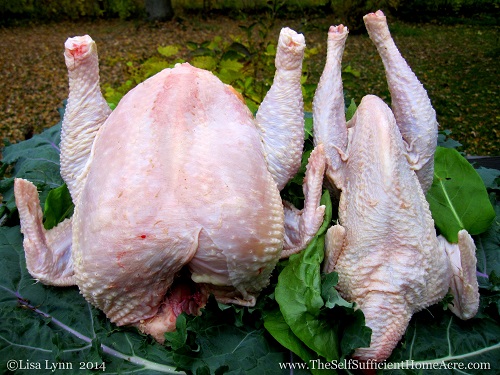

We purchased a free-range dark-feathered Heritage Turkey this year. It was dressed out direct from a local farmer. We were surprised to see dark “tracks” where feathers were, and even a few spots of what looked like blood, under the skin. Is it possible to have a clean looking dressed out Heritage Turkey? Pin-feather problems? We are a small certified organic produce farm (no livestock) and therefore purchased our bird from a neighbor farm.
Hi,
I have had the same issue with my dark feathered birds and it is very difficult to get them really clean looking. There are some light or white feathered heritage birds that will provide a cleaner looking carcass. The Midget White is the first to come to mind, but there are some others.
I did manage to get our Thanksgiving bird pretty darn clean after a lot of picking, scrubbing, and pinching (to remove the dark ‘baby’ feathers, the ones that haven’t broken through the skin, I pinched them like I was trying to remove a sliver)… but I think that someday I would like to try raising the Midget Whites or another light colored bird. It would cut down a lot on the cleaning process.
Best wishes!
Try a white heritage breed such as midget white
I hope to try them someday. Thanks for stopping by!
Thank you so much for your informative posts. For whatever reason my husband selected a bronze poult this spring as I was picking up “filler” chicks for my flock. She grew u with the chicks & we believe she thought she was just a chickzilla. It took her a while to quit chasing our Wellsummer rooster around with her “putt putt purr” calls to mate, LOL! Every night she would head into the coop with the rest of the flock & shove around for her spot on a roost.
She dressed out just shy of 30# & thanks to your post & several others I was able (barely, due to her weight & my lack of strength) do a not terrible job of butchering. I found by re-dipping I was able to get all the pin feathers out of the breast to get it all nice & “clean” looking. Ours was also heavy on the breast & neck fat. Next year I will add split peas along with the whole corn & cut back on the BOSS.
Since I didn’t get around to butchering until this last weekend, I didn’t have time (or really the space, either) to freeze & unfreeze. So instead I did an extended brine in a 3:1 buttermilk & water solution with plenty of brown sugar, salt, pepper & herbs. In about 4 hours we’ll see if that did the trick.
Again, thank you for such great information
So awesome! Loved reading your comment Ria. Congratulations. I am hoping to raise my first turkeys next Spring. A bit nervous but excited about raising our own meats. Happy Thanksgiving.
Hi Ria,
I love the moniker…chickzilla! Lol! I’m so glad that the article was helpful. I have dipped my birds in the scalding water more than once to help remove the extra feathers, but with the bronze birds I still had some trouble getting all those pesky new feathers (the ones that haven’t grown through the skin) off. I’m glad you were able to get yours cleaned up and soaked in brine for Thanksgiving. Let me know how your turkey tasted! 30 pounds is a big bird! I would definitely need help handling one that size. 🙂
Thanks for stopping by and sharing!
We raised a four heritage turkeys last year, but by the time it was to butcher we only had one left. Owls had gotten three of them when they were young. They one we did butcher was very tasty…nothing like store bought birds!
Oh, I’m so sorry to hear about your other tree turkeys, Tracy. Predators need to eat too, but it doesn’t make you feel good when they eat your food! And I agree…they taste so much better than store bought!
We have two Bourbon Reds that were hatched by our broody chicken this past May. The original intent was to have one for Thanksgiving and one for Christmas, and then as luck would have it, we ended up with a male and a female so they’ve been given a reprieve so that they can breed in the Spring (hopefully anyway). So perhaps *next* Thanksgiving, we’ll be dining on our own turkeys!
What luck! More turkeys is always a good thing 😉 Best wishes with your turkey endeavors!
Another great article. Lisa, I am so glad I gravitated back to your page. My page has many followers and we had a rough first year back here in NC after moving from MA last January. But things are looking up and this is the area of homestead life I want to learn about now. With my degree in Hort and twelve years raising produce I have that pretty much down pat. Now to venture into raising our own meat. I will post my two questions here that are pressing on me the most. One is predator safety and escaping. How do you keep your bird safe and do they want to leave if they hear wild turkeys? Will farm turkeys attract wild turkeys to the property and do I have to worry about disease should that happen?
Also how much pasture ground would say 10 birds need? I have about 1/2 acre that I would like to dedicate to this project with some rotational garden space that I could move them too also.
Thank you much for your time and dedication to sharing your knowledge.
Susan
Itzy Bitzy Farm
North Carolina
Hi Susan,
Best wishes with your blog and your homestead in North Carolina…moving is tough. I’ll try to answer your questions here but these give some ideas for sharing more in depth info in a post so I’ll try to get that together soon.
First – predators…I have fox and possums that cause the most predator problems for me. I did lose one turkey hen to a fox because she insisted on brooding her clutch of eggs in the pasture and wouldn’t come in at night. I have to be careful to put my flock away before dark and let them out when it is nice and light out in the morning or I lose birds. There is a manual chicken door that you can purchase and install, but I haven’t made that investment.
Second – wild turkeys…I can hear the wild turkeys calling in response to my turkeys, but they don’t usually come in close to the pasture. However it could happen and this could be a concern if they have diseases. I think that they are usually too shy to get real close unless you live in a suburban area where the wild ones are quite tame. I haven’t had issues with my domestic turkeys trying to leave to join a wild bunch, but I suppose that could happen too. Young turkeys and heritage turkeys are pretty good at flying out of the pasture so I trim the flight feathers on one wing to make it harder for them to escape. When hens are laying their eggs in the spring they are more likely to hop the fence and look for a secluded spot to nest.
I have just a smidge over one acre of land for my whole homestead and the pasture for my entire flock of chickens, ducks and turkeys is probably about 1/6 of an acre. This year I had about 30 chickens, 3 ducks, 1 goose, and 6 turkeys in that pasture. It was plenty of space for them to get exercise, scratch for bugs, and spread out. It isn’t enough land for them to forage for most of their food, however. How much land they need will depend a lot on how good the forage is. If you get a good amount of rain and have rich soil, lots of bugs, etc. then you could easily keep 10 turkeys on 1/6 acre with less feed input. Drought, poor soil, etc will mean you need more space. Put your composting area in the pen and they will eat much of it and turn the rest. To cut down on parasites and disease, rotate their pasture each year and only return them after a full year of laying fallow.
I hope this helps! Thanks for stopping by!
Oh, great news and info. Thank you again. Can they free range with my laying hens (chickens)? I am considering a large turkey tractor to easily free range them and keep them confined and safe. Will they not go to coop or barn on their own at night like chickens? Or prefer nest boxes for laying eggs? Sorry for so many questions, I am a naturally curious person and really really believe in being educated before taking on something for the animals humane and considerate raising. Before April or May which is when I hope to get them. Sounds like a I have plenty of room. So excited!
Hi Susan,
Happy to help whenever I can! I have my chickens, ducks and turkeys together with no problems and I have read of many other people who do the same.
The one thing to consider is a disease called blackhead that is carried by chickens and can be fatal to turkeys. The disease is caused by a microscopic pathogen carried by intestinal worms that chickens can pick up but it doesn’t make them sick…just the turkeys get sick. I think that’s how it works. I have read that some people treat their chickens on a regular basis with acidified copper sulfate to control the intestinal parasites so that their chickens and turkeys can share a pasture. I use the acidified copper sulfate when I see signs of parasites and usually in the fall to keep them healthy.
The turkeys will go inside at night if they have been trained to do so from a young age and there is ample space for them to roost. Sometimes they will decide to roost in a tree instead and this will make them susceptible to predation. So clip one wing and keep them in a new coop, restricting their access to the pasture until they know the coop is home. They will likely follow the chickens in at dusk.
My turkey hen never wanted to use a nesting box. First of all, they are bigger than chickens and won’t fit into a normal nesting box. Second, they are kind of sneaky and seem to have more instinct to hide their eggs. So you will need to keep an eye on the hens to make sure they aren’t trying to leave the pasture to lay a clutch of eggs. Some turkey hens will go broody and raise their own clutch of poults, others won’t. I used an icubator to hatch the eggs. It was basically the same as hatching chicken eggs, but takes a week longer.
A couple of things to be aware of as you start shopping for turkeys…the day old heritage poults are pretty pricey through hatcheries…in the range of $10 to $12 each, plus shipping. You’ll need to order a minimum of 15 for shipping from most hatcheries. You could split an order with someone, or you could order some broad breasted poults to raise for butchering the first fall. They cost less…maybe $5-$6 each and ordering 5 to 10 of those and 5 to 10 of the heritage will bring the order total down some. Or you could do what I did and buy a breeding trio from someone off Craigslist. I spent $75 on a trio of Narragansetts…all of them are gone now, but I have their female offspring and their new boyfriend will be coming to our homestead this afternoon. Well hellooooooo, ladies!
I hope this helps and you have a great experience with turkeys in the spring! Let me know if you have any more questions. 🙂
Great info, LIsa!
We purchased a homegrown Turkey from friends this year. Someday we will add a few to the farm.
I bet you are looking forward to tasty it, Sandra! Best wishes with adding turkeys someday!
Looks like a beautiful bird! We raised our own turkey this year as well.
Thanks, Nancy! That’s great 🙂 Enjoy your Thanksgiving feast!
I’ve been thinking about trying turkeys. I was wanting to get some Broad Breasted Bronze, but since they can’t breed because of the tom’s weight I was thinking about using the Broad Breasted Bronze hens & cross with a standard Bronze tom. The breast should come out larger than the Bronze, but not as large as the Broad Breasted Bronze. What do you think on the idea?
Hi Ken,
I’ve thought about trying that project too. Although I thought about using a white heritage tom and a Broadbreasted White to make the plucking easier. My only complaint with the darker feathered birds is that the dressed bird is hard to get cleaned up nicely. If you try this, please let me know how it goes!